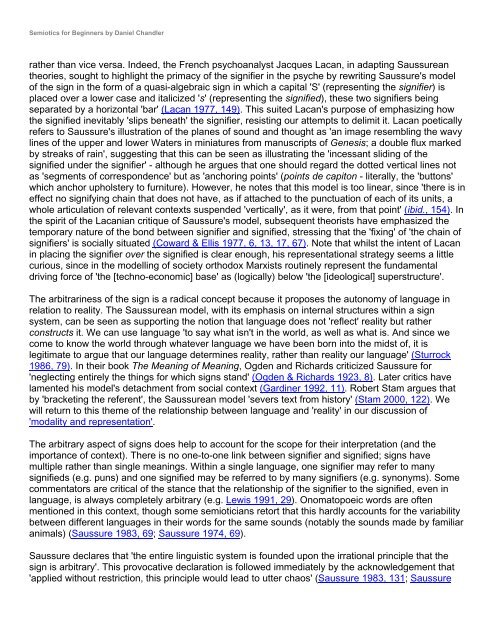Semiotics for Beginners by Daniel Chandler
Semiotics for Beginners by Daniel Chandler
Semiotics for Beginners by Daniel Chandler
You also want an ePaper? Increase the reach of your titles
YUMPU automatically turns print PDFs into web optimized ePapers that Google loves.
<strong>Semiotics</strong> <strong>for</strong> <strong>Beginners</strong> <strong>by</strong> <strong>Daniel</strong> <strong>Chandler</strong><br />
rather than vice versa. Indeed, the French psychoanalyst Jacques Lacan, in adapting Saussurean<br />
theories, sought to highlight the primacy of the signifier in the psyche <strong>by</strong> rewriting Saussure's model<br />
of the sign in the <strong>for</strong>m of a quasi-algebraic sign in which a capital 'S' (representing the signifier) is<br />
placed over a lower case and italicized 's' (representing the signified), these two signifiers being<br />
separated <strong>by</strong> a horizontal 'bar' (Lacan 1977, 149). This suited Lacan's purpose of emphasizing how<br />
the signified inevitably 'slips beneath' the signifier, resisting our attempts to delimit it. Lacan poetically<br />
refers to Saussure's illustration of the planes of sound and thought as 'an image resembling the wavy<br />
lines of the upper and lower Waters in miniatures from manuscripts of Genesis; a double flux marked<br />
<strong>by</strong> streaks of rain', suggesting that this can be seen as illustrating the 'incessant sliding of the<br />
signified under the signifier' - although he argues that one should regard the dotted vertical lines not<br />
as 'segments of correspondence' but as 'anchoring points' (points de capiton - literally, the 'buttons'<br />
which anchor upholstery to furniture). However, he notes that this model is too linear, since 'there is in<br />
effect no signifying chain that does not have, as if attached to the punctuation of each of its units, a<br />
whole articulation of relevant contexts suspended 'vertically', as it were, from that point' (ibid., 154). In<br />
the spirit of the Lacanian critique of Saussure's model, subsequent theorists have emphasized the<br />
temporary nature of the bond between signifier and signified, stressing that the 'fixing' of 'the chain of<br />
signifiers' is socially situated (Coward & Ellis 1977, 6, 13, 17, 67). Note that whilst the intent of Lacan<br />
in placing the signifier over the signified is clear enough, his representational strategy seems a little<br />
curious, since in the modelling of society orthodox Marxists routinely represent the fundamental<br />
driving <strong>for</strong>ce of 'the [techno-economic] base' as (logically) below 'the [ideological] superstructure'.<br />
The arbitrariness of the sign is a radical concept because it proposes the autonomy of language in<br />
relation to reality. The Saussurean model, with its emphasis on internal structures within a sign<br />
system, can be seen as supporting the notion that language does not 'reflect' reality but rather<br />
constructs it. We can use language 'to say what isn't in the world, as well as what is. And since we<br />
come to know the world through whatever language we have been born into the midst of, it is<br />
legitimate to argue that our language determines reality, rather than reality our language' (Sturrock<br />
1986, 79). In their book The Meaning of Meaning, Ogden and Richards criticized Saussure <strong>for</strong><br />
'neglecting entirely the things <strong>for</strong> which signs stand' (Ogden & Richards 1923, 8). Later critics have<br />
lamented his model's detachment from social context (Gardiner 1992, 11). Robert Stam argues that<br />
<strong>by</strong> 'bracketing the referent', the Saussurean model 'severs text from history' (Stam 2000, 122). We<br />
will return to this theme of the relationship between language and 'reality' in our discussion of<br />
'modality and representation'.<br />
The arbitrary aspect of signs does help to account <strong>for</strong> the scope <strong>for</strong> their interpretation (and the<br />
importance of context). There is no one-to-one link between signifier and signified; signs have<br />
multiple rather than single meanings. Within a single language, one signifier may refer to many<br />
signifieds (e.g. puns) and one signified may be referred to <strong>by</strong> many signifiers (e.g. synonyms). Some<br />
commentators are critical of the stance that the relationship of the signifier to the signified, even in<br />
language, is always completely arbitrary (e.g. Lewis 1991, 29). Onomatopoeic words are often<br />
mentioned in this context, though some semioticians retort that this hardly accounts <strong>for</strong> the variability<br />
between different languages in their words <strong>for</strong> the same sounds (notably the sounds made <strong>by</strong> familiar<br />
animals) (Saussure 1983, 69; Saussure 1974, 69).<br />
Saussure declares that 'the entire linguistic system is founded upon the irrational principle that the<br />
sign is arbitrary'. This provocative declaration is followed immediately <strong>by</strong> the acknowledgement that<br />
'applied without restriction, this principle would lead to utter chaos' (Saussure 1983, 131; Saussure




